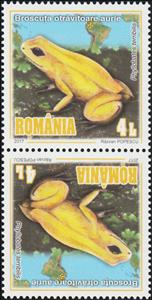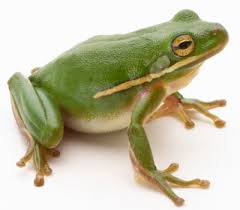Tete-Beche: Golden Poison Frog Tête-bêche Pair Type I (Romania 2017)
Golden Poison Frog Tête-bêche Pair Type I (Romania 2017)
07 December (Romania ) within release The most poisonous animals goes into circulation Tete-Beche Golden Poison Frog Tête-bêche Pair Type I face value 2*4 Romanian leu
| Tete-Beche Golden Poison Frog Tête-bêche Pair Type I in catalogues | |
|---|---|
| Michel: | Mi: RO 7309KDI |
Tete-Beche is vertical format.
Type I tête-bêche pair has one stamp from the top row and one stamp from the inverted second row of the 4x7 sheet. Type II tête-bêche pair has one stamp from the inverted second row and one stamp from the third row of the 4x7 sheet.Also in the issue The most poisonous animals:
- Mini Sheet - Sea wasp (Chironex fleckeri) face value 5*4.50;
- Mini Sheet - Inland taipan (Oxyuranus microlepidotus) face value 5*16;
- Mini Sheet - Southern blue-ringed octopus (Hapalochlaena maculosa) face value 5*3.50;
- Stamp - Golden poison frog (Phyllobates terribilis) face value 4;
- Stamp - Inland taipan (Oxyuranus microlepidotus) face value 16;
- Stamp - Sea wasp (Chironex fleckeri) face value 4.50;
- Stamp - Southern blue-ringed octopus (Hapalochlaena maculosa) face value 3.50;
- Mini Sheet - Golden poison frog (Phyllobates terribilis) face value 5*4;
- Tete-Beche - Golden Poison Frog Tête-bêche Pair Type I face value 2*4;
- Tete-Beche - Golden Poison Frog Tête-bêche Pair Type II face value 2*4;
- Tete-Beche - Southern Blue-ringed Octopus Tête-bêche Pair Type II face value 2*3.50;
- Tete-Beche - Sea Wasp Tête-bêche Pair Type II face value 2*4.50;
- Tete-Beche - Inland Taipan Tête-bêche Pair Type II face value 2*16;
- Tete-Beche - Sea Wasp Tête-bêche Pair Type I face value 2*4.50;
- Tete-Beche - Inland Taipan Tête-bêche Pair Type I face value 2*16;
- Tete-Beche - Southern Blue-ringed Octopus Tête-bêche Pair Type I face value 2*3.50;
Tete-Beche Golden Poison Frog Tête-bêche Pair Type I it reflects the thematic directions:
Amphibians are ectothermic, anamniotic, four-limbed vertebrate animals that constitute the class Amphibia. In its broadest sense, it is a paraphyletic group encompassing all tetrapods, excluding the amniotes (tetrapods with an amniotic membrane, such as modern reptiles, birds, and mammals). All extant (living) amphibians belong to the monophyletic subclass Lissamphibia, with three living orders: Anura (frogs), Urodela (salamanders), and Gymnophiona (caecilians). Evolved to be mostly semiaquatic, amphibians have adapted to inhabit a wide variety of habitats, with most species living in freshwater, wetland or terrestrial ecosystems (such as riparian woodland, fossorial and even arboreal habitats). Their life cycle typically starts out as aquatic larvae with gills known as tadpoles, but some species have developed behavioural adaptations to bypass this.
Animals are multicellular, eukaryotic organisms of the kingdom Animalia (also called Metazoa). All animals are motile, meaning they can move spontaneously and independently, at some point in their lives. Their body plan eventually becomes fixed as they develop, although some undergo a process of metamorphosis later on in their lives. All animals are heterotrophs: they must ingest other organisms or their products for sustenance.
A frog is any member of a diverse and largely carnivorous group of short-bodied, tailless amphibians composing the order Anura[(coming from the Ancient Greek ἀνούρα, literally 'without tail'). The oldest fossil "proto-frog" Triadobatrachus is known from the Early Triassic of Madagascar (250 million years ago), but molecular clock dating suggests their split from other amphibians may extend further back to the Permian, 265 million years ago. Frogs are widely distributed, ranging from the tropics to subarctic regions, but the greatest concentration of species diversity is in tropical rainforest. Frogs account for around 88% of extant amphibian species. They are also one of the five most diverse vertebrate orders. Warty frog species tend to be called toads, but the distinction between frogs and toads is informal, not from taxonomy or evolutionary history.
A map is a symbolic depiction emphasizing relationships between elements of some space, such as objects, regions, or themes. Many maps are static, fixed to paper or some other durable medium, while others are dynamic or interactive. Although most commonly used to depict geography, maps may represent any space, real or imagined, without regard to context or scale, such as in brain mapping, DNA mapping, or computer network topology mapping. The space being mapped may be two dimensional, such as the surface of the earth, three dimensional, such as the interior of the earth, or even more abstract spaces of any dimension, such as arise in modeling phenomena having many independent variables. Although the earliest maps known are of the heavens, geographic maps of territory have a very long tradition and exist from ancient times. The word "map" comes from the medieval Latin Mappa mundi, wherein mappa meant napkin or cloth and mundi the world. Thus, "map" became the shortened term referring to a two-dimensional representation of the surface of the world.




